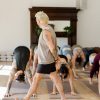
How athletes mentally and physically prepare for a competition varies between individuals, depending on their chosen sport. For great Olympians like American gymnast, Simone Biles and competitive swimmer, Michael Phelps, their routines may differ from how professional basketball star, Dwyane Wade or tennis legend, Serena Williams prepares to step onto their respective courts. These elitists spend years undergoing endurance drills, weighted workouts, multiple practices per day, and neurological training to prepare their brains and bodies for battle. However, they all harbor their most useful superpower of all: their breath.
The way we breathe has the power to impact how we think, what we feel, and the way we move, which is why training the breath is top of mind for some of the most decorated challengers in the game. All athletes use their breath differently within their events, yet they all have the same purpose or goal: to win a title, gold medal, or recognition for their efforts. To examine these superior players, here’s a breakdown of how athletes uniquely use their breath before, during, and after a competition.
Before Competition
At the onset of a yoga class, the instructor generally will guide you through a meditation to bring attention towards the breath. They may ask you to first observe your breath in its natural state without manipulation or judgment before leading you through breathing exercises designed to calm the mind and focus your concentration inward. Similarly, athletes use this technique before participating in a tournament or a competition – they mentally rehearse using relaxation, imagery, and breathing exercises in preparation for the event.
According to the book Mental Training for Peak Performance: Top Athletes Reveal the Mind Exercises They Use to Excel by Steven Ungerleider, mental training has adapted into many professional training programs. It centers the spotlight not only on improving your physical strength and agility, but also on the psychological components. When 1984 Summer Olympics gold medalist Mary Lou Retton obtained her victory for the gold, she used mental rehearsal and visualization methods before her big win by imagining herself performing her routine perfectly. And legendary basketball player Michael Jordan credits his 1989 playoff win with the Chicago Bulls to his mindfulness practice, something many of his teammates fostered. These pre-game rituals became essential for these athletes to feel fully prepared to compete, proving the power mental training has on overall performance.
During Competition
Just like when your yoga instructor encourages slow, focused breathing throughout your practice, how a professional athlete breathes during a competition is vital to the event’s outcome. Improper breathing promotes tension and immobility within the body, increasing your back, neck, and shoulder injury risk. Breath training is what exercise physiologist and physiotherapist James Fletcher focused on when he worked with Olympic swimmer Cameron McEvoy leading up to the 2018 Commonwealth games. His theory (that any yogi would also agree) is that proper breathing techniques can improve exercise performance and reduce anxiety. In his training with McEvoy, he improved the Australian swimmer’s inspiratory flow rate allowing him to take a faster breath, which reduced the amount of time his head turned during his race. Fletcher also trained with Ryan Hipwood, a WSL Big Wave surfer, helping him control his anxiety in between big waves by practicing breathing techniques. He claimed that “by strength training the breath, we give patients great control over their physiology, which has an instant impact on these conditions.”
After Competition
The moment an athlete crosses the finish line, or the sound of the game’s final buzzer, is equivalent to the practice of Savasana for a yogi. It’s the moment at the end of your practice where you can slow your breath and heart rate, reconnecting with your mind and body. When we can accept and surrender ourselves onto the mat both physically and mentally. In fact, many athletes turn towards yoga as a means of an active (and passive) post-game recovery.
Experts recommend that athletes practice active recovery to help restore their muscles after vigorous exercise. By performing a low-intensity activity, blood continues to flow within the body, allowing your muscles to recover and rebuild faster. Practicing tai-chi or yoga after an intense physical workout assists in stretching sore muscles, increases flexibility, and can reduce stress and inflammation. It’s the perfect reward to thank your hardworking muscles after a competition.
Although we may not embody the traits of a celebrated Olympian or a famed tennis star, we can understand part of their training methods that have helped them attain their victories. Athletes can utilize their breath in various ways to manipulate their mental and physical performance while all are working towards the same triumphant goals.







